“Hello, I planted dill and it is dying. The bad news is that tons of Monarch caterpillars are on it. I’m not sure what to do, or how to keep the dill alive. Any suggestions?”
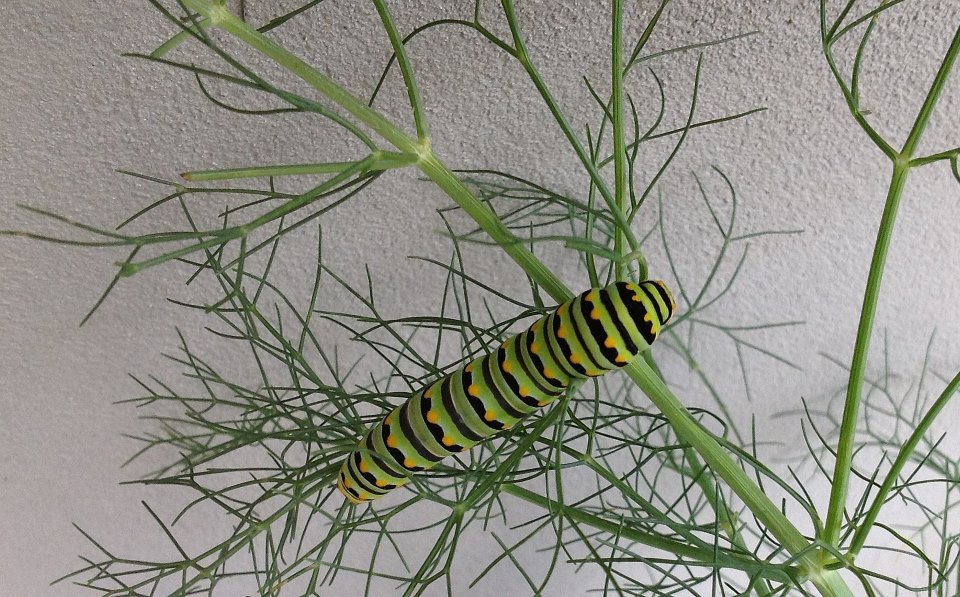
Eastern Swallowtail caterpillar on fennel, one of its host plants. Photo by Monika Maeckle
First of all, Jennifer, a Monarch caterpillar would not be found eating dill, since it only hosts on milkweed species. Host plants–the plant a caterpillar eats and lays eggs on–are often the best clue to what kind of caterpillar is visiting your garden.
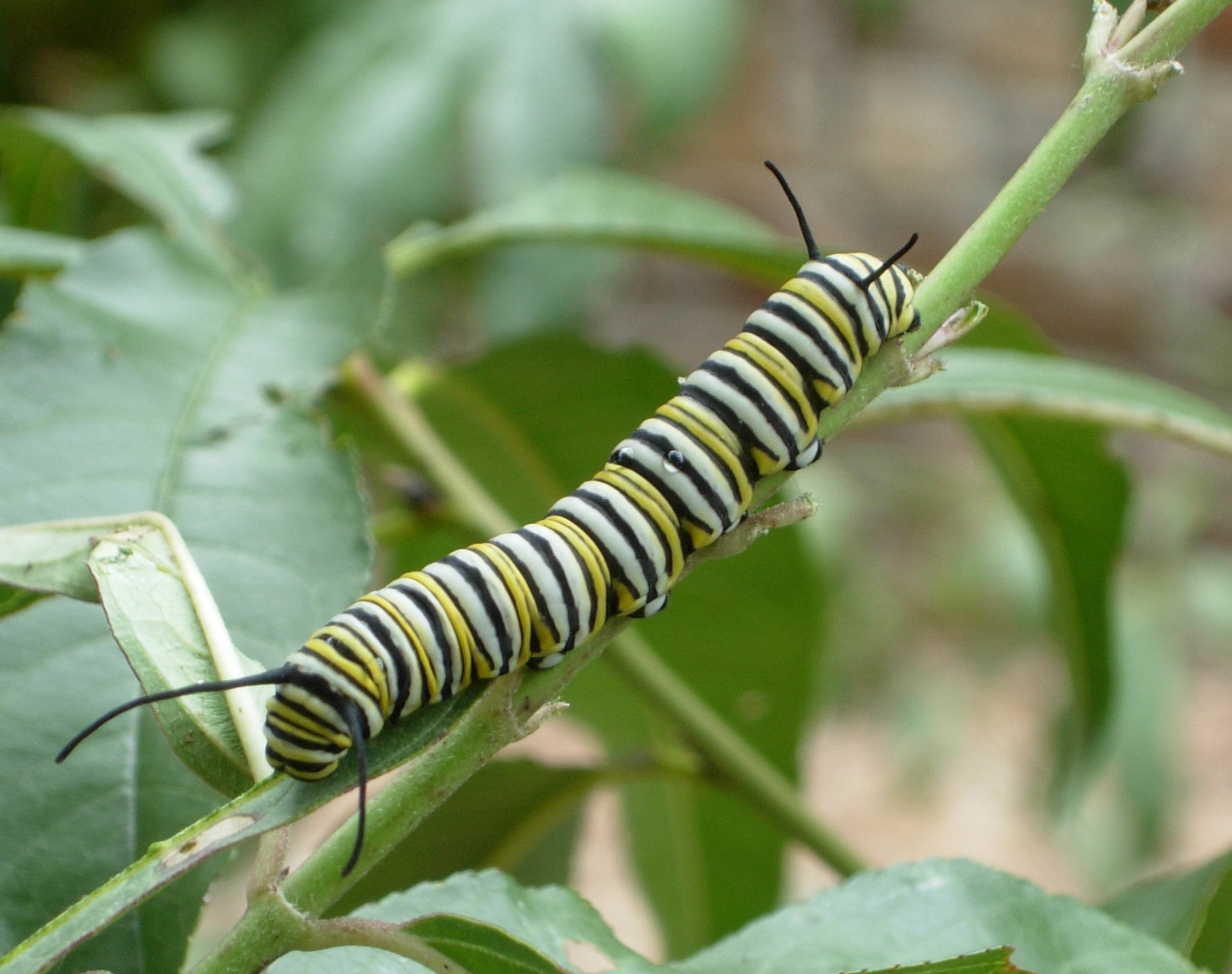
Monarch butterfly caterpillar on milkweed, its host plant. Photo by Monika Maeckle
These two very different butterflies–Monarchs and Swallowtails–grace our Central and South Texas skies regularly. The migrating Monarch appears in spring and fall during its annual migration. The Eastern Swallowtail seems to be present just about year-round, except in extreme cold.
As butterflies, you can’t mistake these beauties for each other. The Monarch, Denaus plexippus, exhibits orange-and-black markings that resemble a stained glass window.
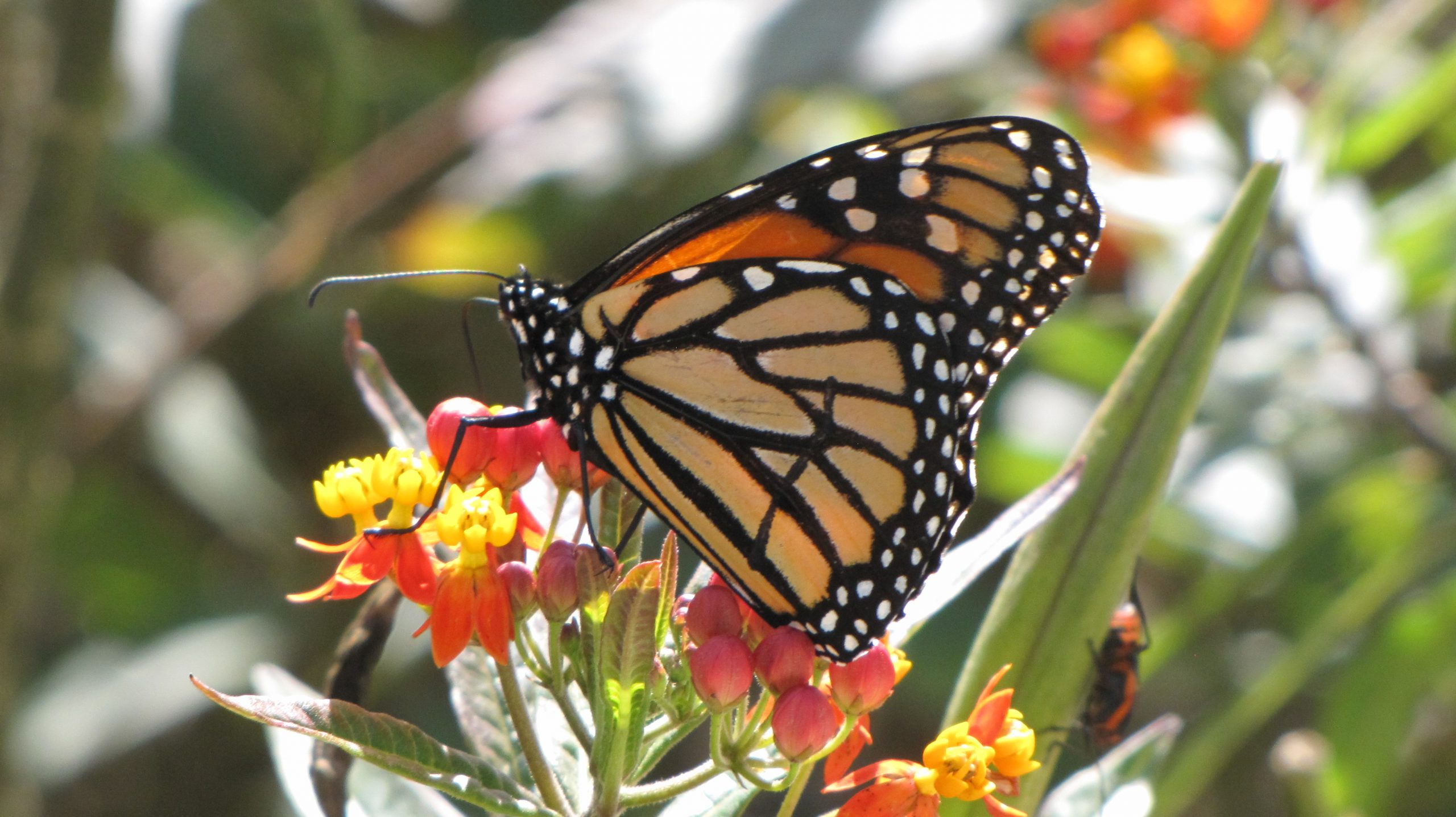
Monarch butterfly, with wings closed, on milkweed, its host plant. Photo by Monika Maeckle

Monarch butterfly, with wings open, nectaring on milkweed. Photo by Monika Maeckle
The dark blue-and-black Swallowtail, Papilio polyxenes, boasts elegant cream, gold and orange dots. Both are large, lovely and can be drawn to your gardens with the right plants.
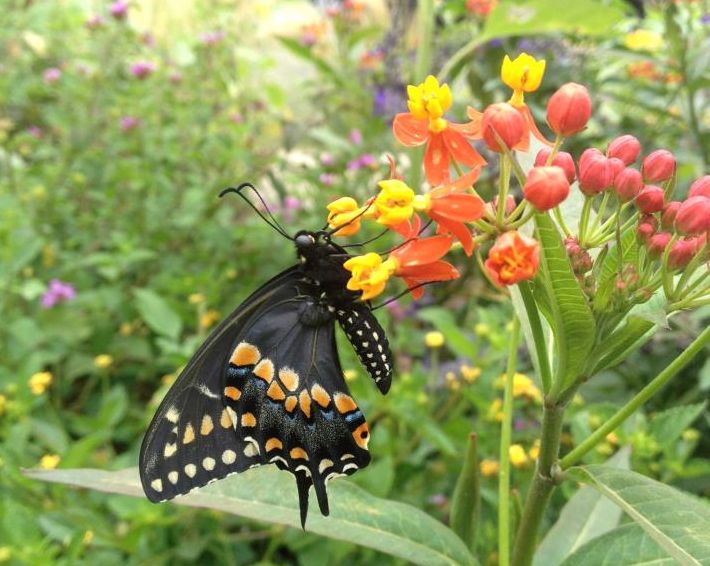
Eastern Swallowtail, wings closed, nectaring on milkweed. Photo by Monika Maeckle
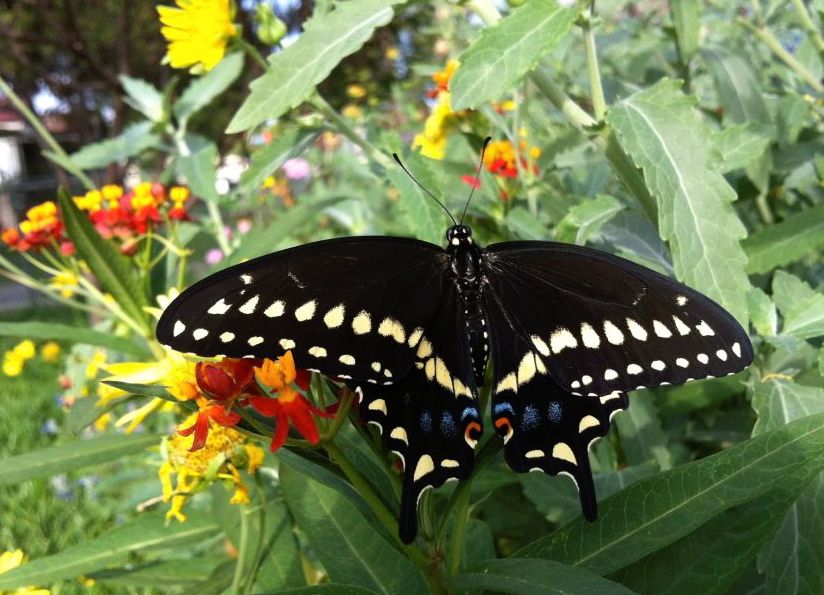
Eastern Swallowtail, wings open, nectaring on milkweed. Photo by Monika Maeckle
Yet as caterpillars, the Monarch and Swallowtail are often confused with each other, as the email that opens this post suggests. Here’s a few tips that should help you pass the “caterpillar quiz” in distinguishing the Monarch and Swallowtail caterpillars from each other.
1. Note the plant the caterpillars are eating.
Checking out the plant a caterpillar is eating generally is the easiest way to tell what kind of caterpillar you’re watching.
Monarchs only lay their eggs on and eat milkweed, members of the Asclepias family. Swallowtails will host on members of the Apiaceae family, which includes parsley, Queen Anne’s Lace, carrot, celery, fennel and dill.
Swallowtails will also host on plants in the citrus (Rutaceae) family, including rue bushes and lemon, lime and orange trees. If you find a green-striped caterpillar noshing on fennel, it’s a Swallowtail; a stripe-suited chomper chowing down on your Antelope Horns is a Monarch.
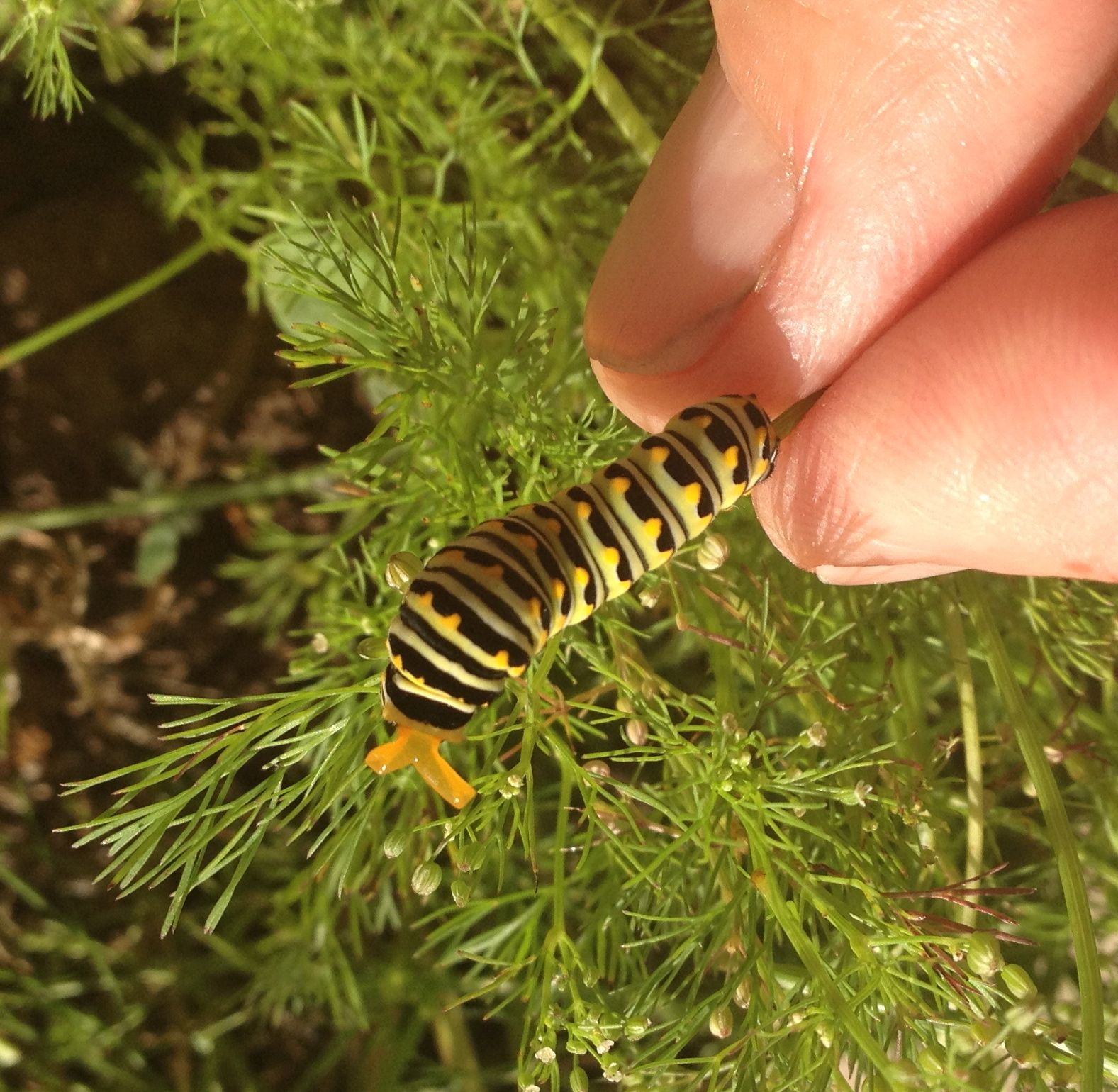
Who goes there?!? Note the yellow “tentacles” which the Swallowtail shows off when bothered. Monarchs don’t do that. Photo by Monika Maeckle
2. Check the tentacles/antennae.
Monarch caterpillars have tentacles on either end of their bodies. The ones in front are technically antennae and have special sensory cells, while the ones on the back are “just for show”–to throw off predators.
Swallowtails, on the other hand, don’t always show their antennae. When bothered or poked, yellow tentacles pop out of their head and emit a distinctive, sickly sweet odor. Kids are always impressed when you provoke the Swallowtail’s tentacles.
3. Note the body shape.
Monarch caterpillars’ body type is consistent in its breadth, while Swallowtail caterpillars are thicker in general, and mass into a “hooded” shape at the head.
In answer to Jennifer’s question about what to do about a lack of dill, I suggest planting plenty of it–some for yourself, and some for the caterpillars. Dill tends to die as summer heats up, so you can also try some of the other Swallowtail host plants. Rue and fennel have worked well for me, thriving even in our Texas heat.
An emergency run to a local nursery might also be in the cards to pick up some caterpillar food. Just make sure it hasn’t been sprayed with any systemic pesticides.
More posts like this:
Like what you’re reading? Don’t miss a single post from the Texas Butterfly Ranch. Sign up for email delivery, like us on Facebook, or follow us on Twitter, @monikam.

Hi all,
Just wanted to let you know that the swallowtail cats love queen annes lace and yellow Alexander. We found one munching on the yellow flowers growing in our field. Come to find out they eat most plants and weeds in the carrot family.
They also love parsely!
Good info! The only thing is the picture of the Monarch catterpillar in this article is actually not a monarch but a Queen.
Hi Karen,
Thanks for writing. You are mistaken about the caterpillar. It is a Monarch. Queens have three sets of filaments, or tentacles/antennae. See the article at the end of the post. –Monika
Do Queen butterflies migrate as Monarchs do? I don’t think we saw any Queens this year. 🙁
Yes, I saw a Queen butterfly migrate in the fall so 2016 with its Monarch cousins that hatched and grew in Katy, Tx.
I raised over 40 healthy Monarch butterflies in 2016 in Katy, Tx to help bring the Texas state insect off the extinction list since, they are already considered to be on the 2015 endangered list.
The front tentacles are touchy/feely sensory organs but they are not “technically antennae.” The monarch caterpillars do have a small pair of antennae in front of the front tentacles.
From Monarch Watch:
http://www.monarchwatch.org/biology/index.htm
There is no such thing as an eastern swallowtail. The larvae eating the dill is a black swallowtail larvae (sometimes referred to eastern black swallowtail). The black swallowtail and the black form of the eastern tiger swallowtail are hard to differentiate in the adult butterfly – but you would never find an eastern tiger swallowtail larvae on dill. Black swallowtail larvae do bare a resemblance to monarch larvae. The larvae you have in the top photo is a black swallowtail larvae – classic shot.
Do black swallowtail butterflies range in Minnesota.? I don’t remember seeing them and I have caterpillars on Dill. My dill dies at the end of the season but I prune the flowers and that helps too keep it making new flower heads longer.
The chrysalis of the monarchs is sometimes attached other places than on milkweed.
You’re correct. There is no such thing as an eastern swallowtail. I have told them that, too, but they’re not correcting the article. They seem happy with spreading misinformation and confusing people. I don’t understand this!
We have a ton of dill in our backyard, we just discovered what we thought were monarch cats on the dill, but see on this discussion that they are swallowtail cats, just fine by me. We have half a dozen, my husband found one by accident and we started looking. We have an insect and bird friendly backyard, and are excited about this!
Congratulations! The birds will find the caterpillars sumptuous, so don’t be surprised if they disappear without a trace. If you want to have some fun, bring one inside. Put some dill in a vase with newspaper underneath and you can watch them grow and develop into the chrysalis. Good luck!
Thanks, will be interesting!
I wish I had seen this post just yesterday when I spied (6) Eastern black swallowtails on my dill. They’ve disappeared without a trace just as you had mentioned above. NOW what can I do to find them again. Am I to assume the birds I feed, came in for a snack or did they move onward? Thanks for answering my question.
Lora
Yeah, birds probably got ’em. NAture is cruel.
I went or to check on my garden today. I have a raised bed. While looking at my dill, which has began to flower, I saw my dill is almost gone. I have one plant, and I stopped counting at 22 caterpillars. I was checking to see what they were, thinking they were monarchs, but have discovered they are swallowtails. Almost as pretty as the monarch. My dtr suggested I should get rid of them, but I’m rather excited to see what happens with them. I’ve got cucumbers and beans near by. . .oh and parsley, but they haven’t bothered them yet.
I was surprised to leaen about the different butterflies. I had thought they were all Monarchs.
I dont know if this pic gets to you but 8 have hached several monarchs in my day i love to watch as they develop but to my surprise today i was m9wing and i found this gat little guy oe gal not sure which but i can’t find it in any fomats have to go back to working now but its black on top has a feeler at the rear and yellow and light green at the under side starting at about halfway down do you know what it is by this description i will try to add a pi thanks for your time and answers seeing how im ocd i absolutely have to know thanks again Red De
[…] and an Eastern Swallowtail caterpillar? Both have yellow, green and black stripes. This website from the Texas Butterfly Ranch shows you photos of the two so you can identify them. My caterpillars are definitely Monarch […]
I found 6 cats on my parsley plant today. After researching they are definitely monarch cats. They are black, yellow and white and have the antennas on the front. I’m puzzled by this as everyone says they don’t feed on parsley? We are wanting to take one and watch it grow in a habitat. Any suggestions?
I am raising, what I now know to be 5 Swallowtail caterpillars that were on my dill plants.They are lovely little fellows and one is now a chrysalis. Hope they all make it. I have each in a bug bottle with lots of dill and we are watching them. Will release when they are butterflies.
Rosemary
How much do they need as they emerge from the chrysalis? I’ve got one that I brought inside in my daughter’s small bug catcher, about 8 inches long, with maybe a 4 inch round door. I’m keeping her in fresh dill (the plant I found her one!), and I’d love to hatch her in here safe from birds and where I can enjoy the process, and then release her, but I want to make sure there’s room for the full grown butterfly. How large a space does she need?
I found this old site. I actually brought an Eastern Black Swallowtail caterpillar in last winter…I t made a cocoon that looked like a dried up leaf. I thought I had killed it, but left it..sometime this spring I got ready to move the container and there was the emerged butterfly..so pretty after showing my aunt and grandson, I let it go.. they only live about 2-3 weeks.
Discovered a Black Swallowtail caterpillar on our Italian Parsley in a planter on the deck for the first time in 22 years of living here in Sioux Falls, SD. Took a few videos of it munching leaves and observed it for several days and this morning it didn’t move for maybe four hours and I did some yard work and came back to find it gone. Fun and educational while it lasted and will plant some Dill in one of my gardens near the Butterfly Bush next year and hope for the best. We have two Prairies covering maybe about an acre total with lots of Purple Cone Flowers, Black Eyed Susan’s, Milkweed and numerous other wildflowers and grasses, so should have plenty of host plants.
We are on the Monarch Migratory route and will be looking forward to their annual visit in hopes they are making a comeback.
Thanks for your website!
Last count 17 swallowtails on the way on my parsley. I wish I could share my picture with you.
I am wondering if some of the chrysalis overwinter or do they complete their metamorphesis before the end of the season and the butterflies leave for the South. I am in Minnesota east of the Fargo-Moorhead area.
I am so excited…I found in/on my Parsley 7 of various sized Eastern Black Swallowtail Caterpillars. My daughter often has the Monarchs in her Kindergarten class, which they enjoy. I have made quite a home inside of which to view the transformations, provide plenty of Parsley and care. Crazy how these guys/gals have sparked this side of me!
I have a large Fennel garden for butterflies to eat. Last week I saw several large caterpillars eating the Fennel (yea), but five days later all caterpillars are gone. Would birds or anything else be eating these caterpillars?
[…] Eastern Swallowtail caterpillars are often confused for Monarch caterpillars because of their stripes. Learn how to tell the difference here. […]
I brought in 15 Swallowtail caterpillars I found on Italian parsley in garden. I put them in large aquarium on screen porch and covered with screen. I bought additional parsley plants for them to eat. It’s amazing how much they eat. They stripped three of them completely of leaves in two days. I put some sticks in as well. 12 of 15 are now in chrysalis stage the other three are still eating. It’s interesting that size had nothing to do with how soon they changed. The last three were the three biggest ones from the first day. I’m looking forward to watching them change then releasing them.
You say that Monarchs only breed on Milkweed and not Dill. But the Butterflies that have emerged ( six of them, and still 3 more caterpillars) are on dill and THEY ARE MONARCHS. They are orange and black, and are strongly marked in almost mosaic pattern. They are not Swallowtail. I do not have Milkweed. This is the third generation this summer.
Today I found 14 swallowtail caterpillars on my curled parsley. I am so excited about this so I don’t really care if they eat up all of my parsley.
PLEASE correct this article. The caterpillars and butterflies that you’re calling Eastern Swallowtails are Black Swallowtails, Papilio polyxenes (not to be mistaken for Easter Tiger Swallowtails, Papilio glaucus). This is really confusing!
Ms. King. By reading your comments, all of us are well aware that you want this article to be changed meet your exacting standards and that you disagree w/the author. You’ve expressed your opinion. Time to let it go and move on.
This article has the wrong name for the swallowtail butterfly. There is no such thing as an Eastern Swallowtail. It is a Black Swallowtail and needs to be named correctly, as that name can be confused with Eastern Tiger Swallowtail.
They need to correct this. As long as this website continues to spread misinformation, I will continue to point it out. If they know that it’s wrong, why won’t they correct it? Don’t they care about telling people the truth? Do you?
If I get cut off I will tell everyone on social media that this is an unreliable source of information.
Why would anyone want to mislead and confuse people? Please explain!
I appreciate your expertise. Terminology matters. I’m trying to figure out exactly what something is.
I just moved to Roswell, New Mexico from Washington State. My husband and I attended the Roswell Dragonfly Bitter Lakes Festival (9-8-2018) with it’s Monarch Butterfly Release! The Park Ranger had a Monarch walk on my arm…it tickled! 🙂 I Love Butterflies…especially the Swallowtail feature…Are there Swallowtail Monarch Butterflies? Love, Jul Taylor
Will butterfly plant die is too many caterpillars eating leaves?
For all is to know about monarch butterflies visit https://monarchwatch.org/
This site is provided by the University of Kansas. We lived in Kansas many years ago and it is definitely the center of the monarch universe!!!!! So many of these beautiful creatures! To see them in your garden avoid using pesticides whenever possible.
This was a great source of information… we are hatching both…monarch & swallowtail at this time it is so exciting!
We have 2 swallow tail caterpillar in our yard eating our celery plant. We are afraid they will be eaten by birds. Where are you keeping them as I would like them to be free.
You really need to rewrite this, identifying the swallowtail caterpillar correctly. This is a Black Swallowtail caterpillar (Papilio polyxenes). There isn’t such a thing as an Eastern Swallowtail. A lot of people get this name confused with Easter Tiger Swallowtail (Papilio glaucus). I’m sure you don’t want to confuse or misinform people?
http://entnemdept.ufl.edu/creatures/bfly/bfly2/eastern_black_swallowtail.htm
You still need to correct this article and change the butterfly ID. It’s incorrect. Besides confusing people, the Papilio polyxenes asterius subspecies on the U of Florida website is not generally recognised, see the North American Butterfly Association: https://www.naba.org/images/papilionidae/papilionidae.html
Actually there are eastern & western black swallowtails. In the link you provided if you click on “black swallowtail” It brings you to a page with pictures of both.
https://www.naba.org/images/papilionidae/papilioninae/papilio_polyxenes/papilio_polyxenes.html
tromachick, I see nothing on that link about Eastern Black Swallowtails. In any case, this article says “Eastern Swallowtails” and there is no such thing. There are “Black Swallowtails”, which are the true subject of the article. There are “Eastern Tiger Swallowtails” which will confuse people. It would be a simple matter to just correct the article. Why not do that?
I love this site, except for the in-fighting and right fighters. I have several caterpillars and, what I thought was poop until it started to move, on my dill plants. Last year I had one cocoon that I kept over the winter and it turned out to be a Swallow Tail. I didn’t want to release it too soon as it was cold out. When is the best time to release it? I couldn’t find any information on how to keep it over the winter, so I just kept it in the garage in a container with holes in the top. Is there a site that tells how to raise them from the poop 🙂 stage to finally freeing them when they emerge? I really need a LOT of help here:) Thanks for any assistance you can give.
Re: caterpillars disappearing. Someone my be able to educate me on this, and I appreciate any info:
this morning I saw a very large praying mantis disturbingly close to some of the swallowtail caterpillars on my dill plants. I fear that it might find the caterpillars an easy meal, so I relocated it to another corner of my garden. Does anyone know if praying mantis eat swallowtail caterpillars or if the caterpillars are noxious?
Yes, praying mantises do eat Black Swallowtail and other caterpillars. Your swallowtail caterpillars are not noxious, because the dill and related plants that they feed on are not noxious. But none of the predatory insects care about the poisonous toxins in monarch caterpillars either. The poisonous and nasty-tasting cardenolides that monarch caterpillars ingest from the milkweeds protect them from most but not all birds and animals.
Predatory insects and spiders are the main reason we need to protect caterpillars.
Thank you for posting this article. I grew up in New England and we had a field of milkweed and every year we were invaded by monarchs. We loved them and I knew that monarchs loved milkweed. Recently I moved to Florida and planted an herb garden and imagine my surprise seeing what I thought were monarch having a picnic in my dill. Your article set me straight.
I can always grow more dill but it’s not every day I get to see swallowtail caterpillars. I’ve decided to put a net over my dill to protect the caterpillars from predators and I am going to plant a lot more dill now. I have them in a five gallon bucket so I need to plant four times as much. One for me with a net to protect the dill and three without to entice more swallowtails. As soon as they are in their chrysalis stage I’ll take the net off and bring them into my porch which is screened. When they emerge I’ll open the door and set them free. I already had a butterfly bush which is visited by more than one species as recommended by my nursery but i wonder why they never mentioned that dill attracts them as well. Yep, gonna need more dill.
This was so helpful found one of these guys on my dill left him to see if he was a monarch but now I kno I have tons of queen annes lace in the back yard I will relocate him to a new home thats not near my garden
Can somebody please correct the information that is being written? Either it’s correct or it’s not. I came to find out what was eating my herbs. I read the article feeling confident that I know what I have. Then started reading comments etc? Please, if it’s not correct, fix it or don’t write misleading articles.